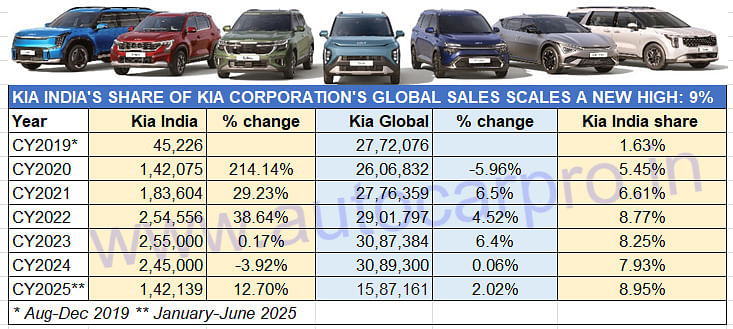Kia Corporation has achieved its best-ever first-half calendar-year sales since it began automobile sales in 1962. The Korean car, SUV and MPV manufacturer has reported total wholesales of 1,587,161 units from January to June this year, marking a two percent increase compared to the first half of 2024.
The sales were driven by new model launches such as the EV3 full-electric SUV – crowned World Car of the Year at the 2025 World Car Awards – along with the EV4 full-electric sedan and Tasman pickup truck, while its core model lineup like the Sportage and Seltos SUVs sustained robust demand.
According to Kia, the Sportage SUV led global sales in the first half of 2025 with 283,512 units sold and an 18% share of model-wise sales. It was followed by the Seltos SUV with 151,049 units (9.51%) and the Sorento SUV with 137,461 units (9% share).

 With 142,139 vehicles sold in the first six months of CY2025, Kia India’s share of Kia Corporation’s global sales has risen to 8.95% – its highest ever.
With 142,139 vehicles sold in the first six months of CY2025, Kia India’s share of Kia Corporation’s global sales has risen to 8.95% – its highest ever.
INDIA AS A KEY GLOBAL GROWTH MARKET FOR KIA CORP
Kia India, which kicked off domestic market sales in August 2019 as a virtually unknown brand in the country at the time, has sold a total of 142,139 vehicles between January and June 2025, up 13% year on year (H1 CY2024: 126,137 units). This makes for an 8.95% share of Kia Corporation’s global sales in the first half of this year.
While this is a 1% increase over the 8% share Kia India had of Kia Corp’s global sales in CY2024, it is now the highest level of contribution to global sales that it has achieved since it began operations in CY2019. The previous highest in terms of Kia India’s contribution to its parent company’s global sales was in CY2022, when it accounted for 8.77% (see data table above).
Since its market entry nearly six year ago with a single product (Seltos), Kia India is now a formidable player in India’s passenger vehicle market with eight vehicles – the Seltos midsize SUV, Sonet and Syros compact SUVs, Carens, Carens Clavis and Carnival MPVs, and the EV6 and EV9. The sales and service network is spread across 744 touchpoints across 329 cities.
